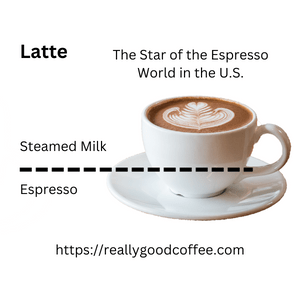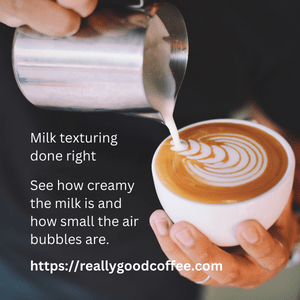
This Is How You Make a Latte.
How to Make a Latte
A latte is an espresso drink made with steamed milk and shots of freshly extracted espresso.
A quality espresso cafe will produce lattes that look like the images on this page. But the reality is many of the lattes you see in the espresso world will not.
We explain why.
This is beginning to change but primarily in areas with a well established coffee culture.
You Can Make a Really Good Latte at Home
If you have a good quality espresso machine with good boiler pressure and you practice a lot, it’s possible to make lattes like this at home.
It will take you some time to figure it all out and there are lots of subtle details. Let’s take a look at some of them.
What You Need…
- high quality fresh whole bean espresso
- an espresso machine
- an adjustable grinder
- milk
- a milk frothing container or
- a milk frothing unit
- tamper
First Things First – the Coffee Beans…
It starts with the coffee beans.
You need delicious coffee beans to make a delicious espresso drink. As far as lattes go, my preference is a blended dark roast. Espresso takes on different flavor characteristics in milk and a lighter roast tends to get lost in the milk.
Single origin beans don’t do so well as espresso in my opinion. As an example, a couple of different shops we visited recently both served single origin Peruvian espresso. The flavor was interesting, and good, but not satisfying. It left us feeling like we still wanted an espresso when we were finished.
Espresso extraction tends to amplify whatever the coffee tastes like. Blends have a broader range of flavors as espresso – and greater depth – so there’s more to amplify.
You might have different flavor preferences which is totally fine. You might really like single origin or a medium roast for your latte.
The point is that in order to make your own latte that YOU LIKE, you need to know what your preferences are. That’s what your favorite barista – the one who makes you the best lattes – has probably already figured out.
You need to experiment until you know what you like – which coffee, blend and roast.
Fresh Roasted Coffee…
Whatever coffee you like, the beans have to be fresh to get the best flavors.
A good rule of thumb: Espresso (well all coffee really) tastes best within two weeks of the roast date.
Many roasters put the roast dates on their coffee bags these days. They didn’t use to.
Fresh roasted coffee beans are the way to go. Working the espresso bar in my shop, I noticed that the flavor profile started fading after the first week. At the end of the second week, it had degraded to a point where the coffee no longer matched our flavor standards. Our solution was to get weekly deliveries from a local roaster, the day after our blend was roasted.
Freshly roasted beans will get you the best flavor.
How to Always Have Fresh Coffee Beans…
The best way to accomplish this is to:
- locate a roaster within a day’s shipping distance – three days max.
- find out what day(s) they roast the blend you want and
- place an order a day or two before that date. Or:
- put in a standing order so that it will ship the day it’s roasted (or the next)
- determine whatever order interval matches your needs.
Your Grinder Is Important…
To make a good latte, you need a good extraction.
In order to get a good extraction, it really helps to have an adjustable burr grinder.
A burr grinder is superior because the consistency of the grind is more controllable. In a burr grinder, there are generally two burs facing each other and you adjust the burrs by separating them further apart or by bringing them closer together.
Burrs pulverize the beans evenly as opposed to a blade grinder that tends to chop the beans as they jump around during the grinding process.
Espresso requires a fine, even grind to get the best extraction. And the way you adjust the length of time of the pour (extraction) is you adjust the grinder. The finer the grind the slower the pour.
Each Coffee Varies a Bit So You Need to Adjust Your Grinder Accordingly…
Each espresso blend has an optimum extraction time for bringing out the best in your coffee. You need to experiment and dial the grinder in. In our blend, for example, the optimum extraction time was 23-25 seconds. So we set the timer and adjusted the grinder until the shots finished extracting in 25 seconds.
About grinders…
- Most commercial espresso grinders start around $800-1000.
- A decent electrical burr grinder for home use starts around $150, generally the burrs are not replaceable when they are dull.
- You can get a pretty good quality manual burr grinder for under $100. But bear in mind hand grinding is time consuming and labor intensive. You can always start with a manual grinder and then upgrade later, keeping the manual grinder for traveling later on.
The Quality of Your Extraction Is a Function of the Quality of Your Espresso Machine
When you extract espresso you want to eliminate variations in boiler pressure and in temperature. Inexpensive espresso machines do not have adequate boiler capacity to maintain constant pressure during extraction, particularly if you are using the same boiler to steam your milk.
Also the recovery time on boiler pressure is typically longer than it should be.
Here’s an interesting post demonstrating the ideal boiler pressure for espresso: 9 bars of pressure.
You have to start somewhere. Today, a relatively inexpensive espresso machine can produce a decent quality espresso. Start with what you can afford and learn the ins and outs of your machine. With a little practice and observation you’ll learn to get the best you can out of that machine.
Milk Texturing Is a Big Deal

Milk Texturing Done Right
To get a latte to look like this, you need to texture the milk properly.
Basic How To Steam Milk:
- Start with cold, fresh milk
- Do not insert the steam wand too deep
- You want to hear a very gentle hiss (kind of a tss-tss-tss) as you steam
- Take your time
If you’re just starting out, mastering the steam wand for steaming and texturing milk is a challenge. It’s part of the “art” in the art and science of espresso.
The Texture of the Milk
The texture of the milk affects the mouth feel of the drink. When you steam it properly, it’s velvety on the tongue and the espresso flavor combines with the milk in a much more satisfying way.
To achieve this, you put the steam wand in the milk just the right depth, with the proper steam pressure and let the milk solids heat evenly and slowly.
It should not be a clamorous event. It is more gentle and precise.

Milk Texturing Example 1
Examples of Milk Texturing
Here are a couple of different examples of milk texturing.
The first is not a latte we ordered it’s a picture of a latte – someone else ordered – as an example to contrast the “milk texturing done right example”.
The second was actually delicious espresso. Exceptional actually. But the milk texturing could use improvement.

latte milk texturing example 2
The drink was prepared with kindness, care and inexperience.
The barista was relatively new still working on the learning curve. If you look, the texture is still better than example 1 visually.
I know what the mouth feel was like and the texture of latte example 2. And even though it could use some texturing improvement, it was a delicious drink.
Latte example 1 more typical of espresso that is served nationwide in the U.S.
The milk texturing done right example is more common in markets like Berkeley/S.F., Seattle, or New York where the espresso culture has been for a long time and is well established.
How To Make a Latte
Now that you have all the stuff you need, let’s make a latte.
First, dose your beans and grind the dose.
Using a Commercial Espresso Grinder
With a commercial espresso grinder, the doser is built in to the grinder. You simply turn on the grinder and it grinds a portion of espresso and then shuts off, or you shot it off. Then you pull the dosing lever and fill the espresso machine portafilter.
After the portafilter is full, you tamp the espresso to get an evenly flattened dose and compressed the right amount so the extraction is optimized.
Most commercial espresso grinders are burr grinders and many are conical burr grinders. Grinders with flat burrs are quite common. That’s what we had in our shop. We got about three months of service life per set of replacement burrs. Conical burr grinders are more efficient in their design and have a more durable and longer service life.
Using a Home Grinder
You will have to experiment to find out how much espresso you need in a “dose” in your home espresso machine. It will vary because of:
- size of your portafilter
- the boiler pressure and pressure capacity of your espresso machine
- the operating temperature
- the grind of your beans
- how you tamp the beans in the portafilter
The way you find out is to weigh the beans and keep track until you find your optimum dose for that machine. In other words you keep adjusting your grinder to grind the coffee finer until you get the best flavor and a pour around 25 seconds.
You try the the extractions with different amounts of beans, and using a finer or courser grind until you dial it in.
If you’re not sure where to start, call the company who made your machine and ask them where to start – as far as a range for a dose goes. Ask how many grams of espresso beans should you be using per portion in their machine. They will help you.
You can use any scale that measures grams. I bought an inexpensive digital espresso scale from Amazon for under $20. Simple and reliable.
Once you know the weight you need to grind for each dose, you’re good to go.
For Each Shot of Espresso, You Tamp the Ground Beans
You have seen baristas use tampers at espresso cafes. So you fill the espresso machine portafilter with a “dose”. Then you tamp it to flatten the pulverized espresso beans in the portafilter, load the portafilter into the machine, push the brew button and extract the espresso.
When the extraction is complete, you’re looking for a kind of dry coffee donut when you turn over the portafilter to get the spent grinds out.
When You Can, Extract the Espresso into a Pre-heated Porcelain Cup.
Preheating the cup keeps the espresso hotter until you pour the steamed milk into the cup.
Personally I like to steam the milk while the espresso is extracting and then feather the milk into the espresso once the extraction is complete – so that everything stays hot.
When You’re Steaming and Texturing the Milk
Stop around 140 degrees.
Don’t scorch the milk. You’ll know you scorched it when the smell of the milk changes. The first time you do it, you’ll know what you did. Throw out the scorched milk and start over with cold fresh milk.
You can get thermometers with a little clip on the shaft to attach to the top of the milk frother. Once you do it enough times, you’ll know by the heat of the milk container in your hands while you’re steaming it.
Hold the Cup in Your Hand with the Espresso in It
Like the picture above, feather in the hot milk into the espresso.
Voila, you have a latte.
Why the Latte Is the Star of the Espresso World in the U.S.
Starbucks made lattes fashionable.
My guess why the latte is the star of the espresso world in the U.S. is that Howard Schultz is a great marketer. He created one of the strongest brands in the food service industry and one of the best known brands worldwide.
Lattes are the espresso drinks that made it possible even for non-coffee lovers to participate in the “espresso” social experience. Just by adding the milk, you mask some of the espresso flavor.
You can also take part in the “seasonal latte flavors”: like a mint-chocolate mocha or pumpkin spice grande with cinnamon. Ask for vanilla, hazelnut or Irish cream to the latte to mask the coffee a little more – if you don’t like coffee. You can still hang out with your friends who do like coffee and be fashionable doing it.
The Latte Is a Modern Mini Affordable Luxury
Regardless of the economy, people who don’t have much money can still manage to reward themselves with a latte. It has become a form of a social reward mechanism.
You may not be able to afford the car you want, but you can get yourself a latte.
Maybe you can’t afford steak, but you can get yourself a latte.
The Latte Is a Social Experience
“Let’s grab a latte.”
It’s like the social media of food.
There you have it.
Enjoy learning how to make a latte, your latte.

Thanks.
You’re welcome.
My site got hacked just got it back up tonight. Didn’t see your comment before.